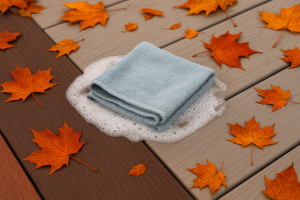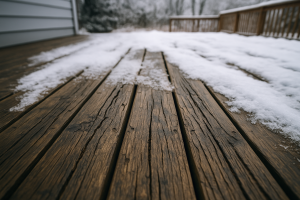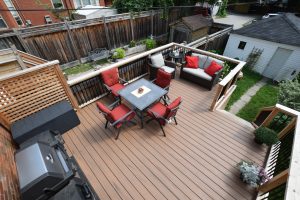As winter approaches, it’s crucial to ensure your deck remains in excellent condition and withstands the harshest of weather. This guide offers 10 straightforward steps to winterize your deck effectively, allowing for its continued enjoyment come spring and summer.
Why Protect Decking During the Winter?
In many areas, winter means challenging weather—rain, snow, and ice. Extreme conditions can affect all deck types, whether wood, composite, or PVC, underscoring the importance of timely preparation.
Failing to winterize can lead to issues like:
- Decreased longevity (extreme damage may even mean you need to replace your decking come spring)
- Safety issues
- Aesthetic problems
- Costly repairs and replacements
But winterizing not only prevents these problems, it also eases your spring maintenance.

10 Ways to Prepare and Protect Your Deck for Winter
1. Clear Debris
The first step in getting your deck ready for winter is to remove any debris that has settled on the surface. Accumulated debris can trap moisture, leading to mold and mildew growth, which will hasten wood deterioration. This problem is especially likely to occur if you have a traditional wooden deck as opposed to composite or PVC decking.
Keep in mind that this may not be a one-time job. If you aren’t covering your deck during the fall and winter months, you’ll need to regularly remove any debris that lands on your deck.
Trim Nearby Trees and Plants
To minimize the amount of debris landing on your deck, trim any trees and plants that are nearby. Even if the foliage doesn’t shed its leaves (like evergreen trees), snow and ice may cause tree branches to break and damage your deck. Therefore, trimming overgrown branches and foliage can help extend the life of your deck. If your deck has an overhead structure or is located near the house, you’ll also want to ensure that gutters and downspouts are clear of debris. Proper drainage will help prevent water from flowing onto the deck.
2. Clean Your Deck
Once debris is removed, you’ll need to thoroughly clean your decking. Exactly how you clean the deck will depend on the type of decking it’s made from.
A key benefit of TruNorth’s composite and PVC decking is their ease of cleaning, saving you time compared to traditional wooden decks. If your composite or PVC deck isn’t very dirty, washing it with warm water and soap should do the job. Remember to clean between deck boards, where dirt or debris may have accumulated. For decking that needs a deeper cleaning, opt for a power washer and/or specialized deck cleaning product.
For those with a TruNorth deck, cleaning is simplified! You can safely use a pressure washer at pressures less than 1,700 psi. If you have a Clubhouse deck, use a pressure washer at less than 1,100 psi. Additionally, wash in the direction of the grain pattern to avoid any damage to the decking. You can also consult the TruNorth and Clubhouse Decking Care & Maintenance Guide for more details. Wooden decking can also be cleaned with a power washer but is much more difficult to clean with only soap and water.

3. Inspect for Damage
Now that your deck is clean, the next step in protecting and preparing your deck for the winter is to inspect it for damage. This damage may include:
- Loose deck boards
- Rotting deck boards
- Loose or missing screws or fasteners
- Mold or mildew
- Structural issues
If any of these signs of damage are visible, it’s important to fix them before the winter season arrives. Cold, wet, and snowy weather is highly likely to worsen the damage and decrease the life of your deck. Fixing issues now will also mean you have much less to do when you come to clean your deck for the summer.
Replace or repair what you can, and call in a licensed professional as needed. Another advantage of TruNorth’s composite and PVC decking? They’re far less prone to damage compared to their wooden counterparts. If you’re planning on replacing your deck, choosing PVC or composite over wood means that protecting your deck in the winter will be much easier.
4. Seal or Stain Your Deck
If you’re working with a wooden deck, sealing or staining before the winter is crucial. This step shields the wood from moisture and extreme winter conditions.
However, if you’ve chosen TruNorth’s PVC or composite decking, you can skip this routine. Unlike wood, which often requires annual re-staining and re-sealing, TruNorth decks are designed to remain resilient without these extra steps. In fact, TruNorth Composite Decking can last 25 years or more, free from the hassles of staining, painting, and sealing!
5. Remove and Store Furniture
If you have outdoor furniture on your deck, consider storing it indoors or in a covered area for the winter. Doing this will protect it from moisture, snow, and freezing temperatures, which can cause damage to wooden and metal furniture. If you don’t have a place to store the furniture, cover it with waterproof furniture covers.

6. Elevate Planters and Containers
Raising planters off the deck is an often overlooked winterizing step. You can do this using saucers or pot feet. In doing this, you prevent water from pooling underneath the planter and on top of the deck, which will cause damage to your decking (especially if it is wooden decking).
Alternatively, remove the planters from your deck altogether. This will be necessary if you plan on covering the deck with a protective tarp.
7. Regularly Remove Snow
In the winter, it’s highly likely to snow; therefore, you need to be prepared to remove this snow from the deck throughout the season. After snowfall, use a plastic snow shovel or a broom with soft bristles to sweep away snow from your decking. You could also opt for a snowblower.
Letting snow sit can lead to moisture damage. Fortunately, TruNorth’s materials resist such issues better than traditional wood. While all types of decking can suffer damage from snow or ice, wooden decking is the most prone to this type of deterioration. This makes PVC or composite decking an excellent choice if you live in an area prone to snow.

8. Avoid Melt Products
While removing snow is an excellent way to protect your deck for winter, you need to be careful with ice melt products; potentially avoiding them completely. Some ice melt products are harsh on wood and may damage the finish or the wood itself.
You also need to be careful when using these products on composite and PVC decks. Always check the manufacturer’s recommendations to determine if ice melt products can be used.
In place of ice melt, sweep away excess ice. You’ll also want to avoid using metal shovels or other tools that may damage the decking when clearing ice.
Check for Ice Dams
If your deck has a roof or is under an overhang, check for ice dams. These can cause water to back up and seep into the deck’s structure, so you’ll want to remove ice dams if they occur. Ice may also fall onto the deck, potentially causing damage.
9. Consider a Deck Cover or Other Protectors
If you live in an area with heavy snowfall or other extreme winter conditions, you may want to cover your deck with a tarp for the winter. You could also opt for an awning to protect your deck from the elements.
Along with using deck covers for winter, you may want to consider using protectors or mats under heavy furniture if you cannot remove the furniture from the deck and put it into storage. This helps to protect your deck surface from scratches, moisture, and other damage.
To further protect your deck, especially if it’s made of Clubhouse material, consider our Dexerdry Weather Diverting System. This revolutionary system comprises thermoplastic inserts that fit between the grooves in your decking. This waterproofs the deck and keeps any area underneath it completely dry. This system is especially useful if you have storage space below your deck or if the deck is on a second or third floor.
10. Do Regular Inspections of Your Deck
Throughout the winter, check your deck periodically for damage or other issues. If you notice anything of concern, fix the problem straight away. Damage to a deck is concerning any time of year, but winter weather conditions can worsen the damage, making it even more important to act quickly.

In Conclusion
Proper winter care, especially with TruNorth’s premium decking, ensures your deck’s beauty and durability year after year. By understanding how to protect and prepare your deck for the winter, you can help prolong its lifespan and keep it looking great for next summer, and many years to come.
Composite and PVC decks demand less winter care compared to wood. In addition, these materials will last longer than wood and are less prone to a variety of issues, from insect infestation to water damage, mold, and rot.
Ready to elevate your outdoor space with a stunning composite or PVC deck? Explore the exceptional choices of Clubhouse PVC Decking and TruNorth Composite Decking. Experience the peace of mind that comes with a 25-year or lifetime guarantee, and unleash your creativity with an array of finishes and colour options. Your dream deck awaits – start building it today!




